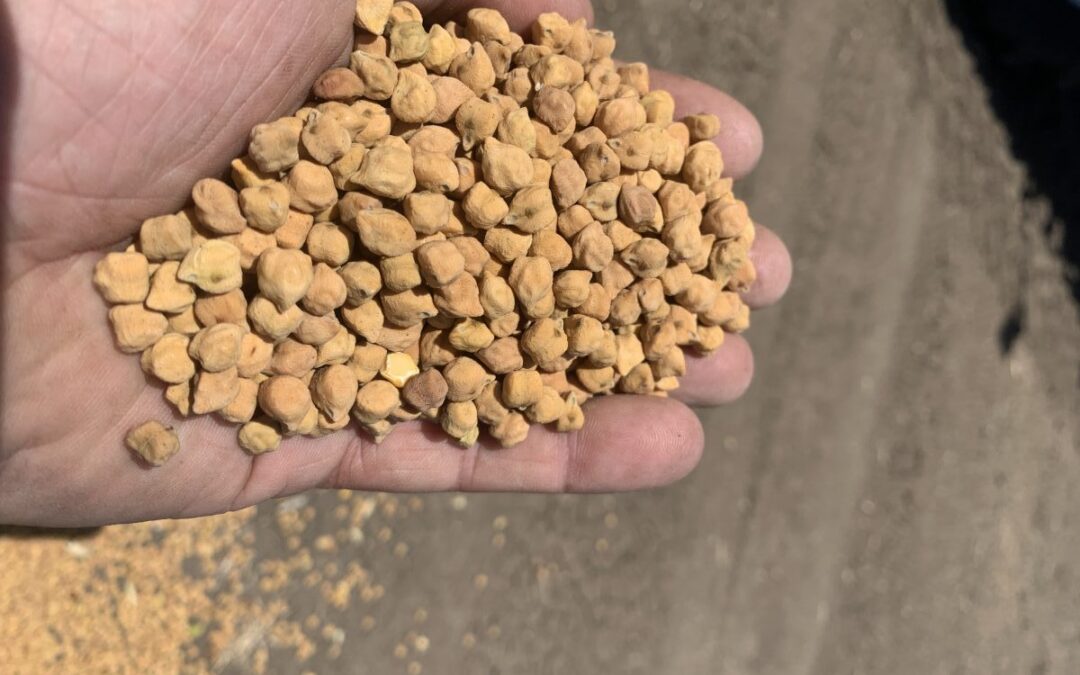Liz Wells, January 30, 2023
CHICKPEA area in northern New South Wales and southern Queensland could fall even further this year as lacklustre export prices deter growers from the pulse, which in the past decade has become the preferred crop to grow in rotation with wheat.
At roughly $500 per tonne delivered packer, and lower because of rain-related downgrading in the past two harvests, chickpea prices are down from $900/t and more in 2016-17, prior to India’s imposition of a tariff.
ABARES data indicate Queensland’s chickpea crop fell from a record 1.15 million tonnes (Mt) from 550,000ha in 2016-17 to 350,000t from 205,000ha in the 2022-23 harvest.
NSW harvested 192,000t from 160,000ha in 2022-23, down from the record 792,000t from 480,000t in 2016-17.
The Queensland area could hold steady based on Central Queensland, where growers have less rotational options, and slightly better price prospects based on its earlier harvest and generally better quality.
The NSW area is likely to fall further in the 2023-24 crop year as growers look to crops including wheat on wheat, despite its inherent disease risks, as well as barley and canola.
Disease risk high
Delta Ag Moree agronomist Rob Long said chickpea area in the wider Moree region as a percentage of winter crop had fallen sharply for many growers from around 25-30pc to zero in some cases.
He attributed the drop to conditions last year having been so wet and the chickpea market having been relatively depressed, and said the reduced chickpea planting has upended rotations.
“That essentially has been replaced with wheat on wheat for the past two years; that leads to build-up of root-lesion nematodes and crown-rot inoculum and yellow leaf spot and other leaf diseases,” Mr Long said.
Ideal conditions in 2020 followed the drought of 2017-19, and wet years in 2021 and 2022 made rotations difficult to follow because conditions were either too dry or too wet to get some crops planted on time or at all.
“There’s a lot of pressure in getting rotations back to where they were.”
A plunge in desi chickpea values, based on India’s imposition of chickpea tariffs in 2017, has made the pulse difficult to market as well as grow in the past two years.
“In northern NSW, there’s a lack of confidence in growing chickpeas, and that has put pressure on farming-system rotations.”
While topsoil in large parts of southern Queensland and northern NSW has dried out, the full subsoil moisture profile points to 2023 being an ideal season for chickpeas.
“Agronomically, this could be a great year to grow chickpeas; marketing wise, they’re still under pressure.”
Many growers still have unsold chickpeas from the past two harvests stored on farm, and some are considering growing more faba beans, or introducing the crop into their rotation, as an alternative.
However, they are susceptible to chocolate-spot disease, and prices are far from inspiring although they do, unlike chickpeas, have a domestic sale option because of the stockfeed market.
“The alternative becomes summer crop — sorghum and dryland cotton — and that has replaced some chickpea area.”
Mr Long said barley appeared to be in favour in rotations in northern NSW as growers started to map out their planting intentions for 2023.
“It is a bit of a stopgap measure; it’s not solving disease inoculum problems, and it’s just buying time to be able to find another more suitable crop.”
Canola is also on the radar, even though its chances of running into its fourth consecutive mild spring after timely sowing in the region this year are unlikely.
“Canola’s had three brilliant years, but if it runs into a spring that’s hot and has frost, it’s in trouble.
“That’s days that get up to 28 degrees with a minus 2 degrees overnight, and you can certainly get those in Walgett and Mungindi and places like that.”
Mr Long said the ability of wheat, even crops that went against the science and followed wheat in the rotation, did surprisingly well in the 2022-23 harvest quality stakes, and this could be sending a false sense of security to growers when it comes to flirting with disease risk.
“There was quite a bit of fusarium head blight evident in crops but it surprised us, as that grain which didn’t develop, or didn’t develop fully, blew out the back of headers.
“Generally amongst growers and advisors, during (wheat) head development, we were concerned about what the quality of the crop was going to be like, and everyone was pleasantly surprised at the result.”
Canola on radar on Western Downs
At Condamine, grower Andrew Butler intends to plant the usual paddock of chickpeas after missing out last year because of wet conditions.
The Butlers farm six paddocks on a six-year rotation: wheat followed by chickpeas followed by back-to-back wheat crops and ending with a summer crop.
“Wheat’s our most profitable crop; that’s the centre of our rotation, and as long as we do get those break crops in, we don’t have crown rot problems,” Mr Butler said.
“We shouldn’t be planting wheat on wheat on wheat, but we’re probably going to, even though we know the potential for disease.”
He said the reason for running the gauntlet is economic: “A wheat crop full of crown rot is better than a chickpea crop.”
He said proper nutrition and disease control helped to minimise the risk, as did avoiding planting wheat varieties with high susceptibility to disease.
Last year, the Butlers recorded a record average yield of 6.46 tonnes per hectare for milling and feed wheat.
Mr Butler did not plant chickpeas last year because of wet conditions prevailing to the end of the sowing window.
“We’ve got dryland cotton in that paddock now, so now that rotation’s out of sequence, but we will plant chickpeas, and try to keep the rotation.”
The Butlers will grow cotton “on a super-full profile and a reasonable rainfall outlook”
“We had one paddock that missed a sorghum crop because of drought, so that turned into a two-year fallow.”
The Butlers are planting some test strips of canola for the first time, and will not be going back to barley because previous gross margins put it well below wheat.
This is despite it being a popular inclusion in the wider region’s feedlot rations, and barley currently trading at evens with SFW wheat, compared with its normal discount of at least $20/t.
“Barley’s had a resurgence in the past few years, and people around here are growing it again now, but in terms of your rotation, it’s not going to solve problems if you have them.”
Source: Grain Central

